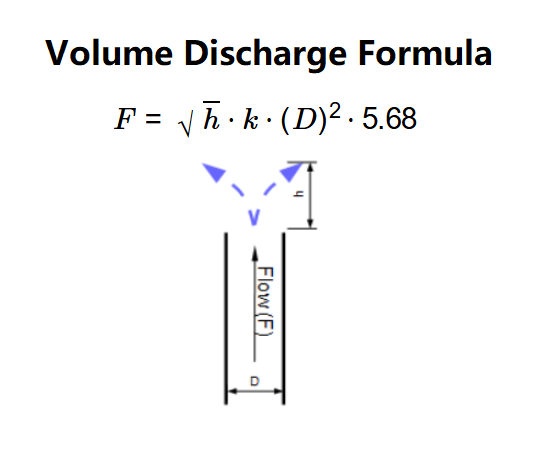1. What is Volume of Vertical Discharge Calculator?
Definition: This calculator computes the flow rate (\( F \)) of water exiting a vertical pipe, based on the height of the water plume (\( h \)), the flow coefficient (\( k \)), and the diameter of the pipe (\( D \)).
Purpose: It helps engineers and hydrologists determine the volume of water discharged per unit time from a vertical pipe, useful for designing irrigation systems, fountains, or plumbing systems.
2. How Does the Calculator Work?
The calculator uses the following equation:
- \( F = \sqrt{h} \cdot k \cdot (D)^2 \cdot 5.68 \)
Where:
- \( h \): Height of the water plume (in mm, cm, m, in, ft, or yd);
- \( D \): Diameter of the pipe (in mm, cm, m, in, ft, or yd);
- \( k \): Flow coefficient (default 0.97, ranging from 0.87 to 0.98);
- \( F \): Flow rate (in gal/min, gal/s, gal/h, L/s, L/min, L/h, mL/s, mL/min, mL/h, qt/s, qt/min, or qt/h);
- Results are displayed with 3 decimal places (or scientific notation if less than 0.001).
Steps:
- Enter the height of the water plume (\( h \)) and select the unit (mm, cm, m, in, ft, yd).
- Enter the diameter of the pipe (\( D \)) and select the unit (mm, cm, m, in, ft, yd).
- The flow coefficient (\( k \)) is set to 0.97 by default.
- Click "Calculate" to compute the flow rate.
- Change the result unit dropdown to convert the flow rate to a different unit.
3. Importance of Volume of Vertical Discharge Calculation
Calculating the volume of vertical discharge is crucial for:
- Hydraulic Engineering: Designing systems like fountains, sprinklers, or vertical drainage pipes.
- Irrigation Systems: Ensuring adequate water flow for effective distribution.
- Plumbing Design: Optimizing pipe dimensions for efficient water flow in vertical setups.
4. Using the Calculator
Example 1: Calculate the flow rate with \( h = 1 \, \text{in} \), \( D = 1 \, \text{in} \), result in gal/min:
- Height of Water Plume: 1 in;
- Diameter of Pipe: 1 in;
- Flow Coefficient: 0.97;
- \( F = \sqrt{1} \cdot 0.97 \cdot (1)^2 \cdot 5.68 = 1 \cdot 0.97 \cdot 1 \cdot 5.68 = 5.510 \, \text{gal/min} \);
- Result: Flow Rate = 5.510 gal/min.
Example 2: Calculate the flow rate with \( h = 0.5 \, \text{m} \), \( D = 2 \, \text{cm} \), result in L/s:
- Height of Water Plume: 0.5 m = \( 0.5 \times 39.3701 = 19.685 \, \text{in} \);
- Diameter of Pipe: 2 cm = \( 2 \times 0.393701 = 0.787 \, \text{in} \);
- Flow Coefficient: 0.97;
- \( F = \sqrt{19.685} \cdot 0.97 \cdot (0.787)^2 \cdot 5.68 \);
- \( \sqrt{19.685} \approx 4.437 \), \( (0.787)^2 \approx 0.619 \), so \( F \approx 4.437 \cdot 0.97 \cdot 0.619 \cdot 5.68 \approx 15.132 \, \text{gal/min} \);
- Convert to L/s: \( 15.132 \times 0.0630902 \approx 0.955 \, \text{L/s} \);
- Result: Flow Rate = 0.955 L/s.
5. Frequently Asked Questions (FAQ)
Q: What is Volume of Vertical Discharge?
A: It is the flow rate of water discharged from a vertical pipe, influenced by the height of the water plume, pipe diameter, and flow coefficient.
Q: Why is the flow coefficient fixed at 0.97?
A: The value 0.97 is a typical flow coefficient for vertical pipes with heights up to 2 feet, accounting for friction and other losses.
Q: How does pipe diameter affect the flow rate?
A: The flow rate increases with the square of the pipe diameter, meaning larger pipes result in significantly higher flow rates.
Volume of Vertical Discharge Calculator© - All Rights Reserved 2025
 Home
Home
 Back
Back
